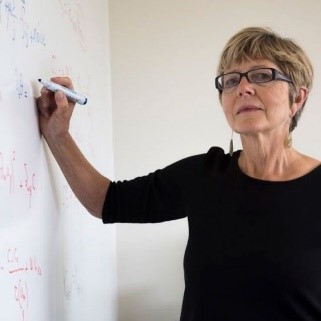
Maria Cristina Marchetti is Distinguished Professor of Physics, UC Santa Barbara. She is an Italian-born, American theoretical physicist specializing in statistical physics and condensed matter physics. In 2019, she received the first Leo P. Kadanoff Prize of the American Physical Society, and was elected to Fellowship of the National Academy of Sciences. Earlier awards include Fellow of the American Physical Society, 2000, Chancellor’s Citation for Academic Achievement, Syracuse University, 2005, Fellow of the American Association for the Advancement of Science (2013), and Member of the American Academy of Arts & Sciences (2014).
Following her PhD degree in Physics from the University of Florida in 1982, and several postdoctoral appointments, she joined the faculty at Syracuse University from 1987 to 2018. She held the William R. Kenan, Jr. Distinguished Professorship of Physics there, was the director of the Soft and Living Matter program, and chaired the department 2007–2010. From 2018 to present she has been a Distinguished Professor of Physics at the University of California, Santa Barbara.
Marchetti served as co lead-editor of the journal Physical Review X (PRX), a journal run by the American Physical Society (APS) 2016 – 2021. She was vice-chair and chair of the APS Group of Statistical and Nonlinear Physics from 2005 to 2008, and chair of DSOFT – the APS Division of Soft Matter – 2016-2017. She became a co-editor of the Annual Review of Condensed Matter Physics as of 2017.
Her current research is focused on emergent behavior of active and living matter. Active systems are assemblies of interacting entities that individually consume energy to generate motion and collectively exhibit organized behavior on scales much larger than that of the individuals. The active matter paradigm is relevant to phenomena on many scales, from control of human crowds to the collective migration of epethelial cells in wound healing. Theory and computational methods are employed to make complementary use of bottom-up modeling and top-down phenomenology to investigate the self-organized structure and mechanical properties of these complex systems.
IFT talk/seminar
Physics Colloquium: “The Physics of Active Matter”
October 5, 2023
3:00pm 1002 NPB
Birds flock, bees swarm and fish school. These are just some of the remarkable examples of collective behavior found in nature. Physicists have been able to capture some of this behavior by modeling organisms as “flying spins’’ that align with their neighbors according to simple but noisy rules. Successes like these have spawned a field devoted to the physics of active matter – matter made not of atom and molecules but of entities that consume energy to generate their own motion and forces. Through interactions, collectives of such active particles organize in emergent structures on scales much larger than that of the individuals. There are many examples of this spontaneous organization in both the living and non-living worlds: motor proteins orchestrate the organization of genetic material inside cells, swarming bacteria self-organize into biofilms, epithelial cells migrate collectively to fill in wounds, engineered microswimmers self-assemble to form smart materials. In this lecture I will introduce the field of active matter and highlight ongoing efforts by physicists, biologists, engineers and mathematicians to model the complex behavior of these systems, with the goal of identifying universal principles.